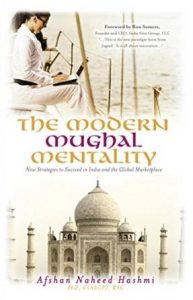 In this slim volume, India-born business advisor and entrepreneur, Dr. Afshan Naheed Hashmi presents examples and case studies detailing how Indian businesses have confronted challenges and created successful enterprises, both within India and internationally, using the principles of jugaad.
In this slim volume, India-born business advisor and entrepreneur, Dr. Afshan Naheed Hashmi presents examples and case studies detailing how Indian businesses have confronted challenges and created successful enterprises, both within India and internationally, using the principles of jugaad.
We are told in the preface that the Indian word jugaad means many things and can be interpreted in many different ways, however Hashmi defines jugaad as “obtaining your objectives by maximizing resources through thinking outside the box.” Not exactly a mind-blowing business concept. While each example in the book illustrates one aspect of jugaad, there is nothing new or terribly interesting about jugaad itself.
Thousands of business books have been written on drearily similar concepts, from The Art of War to Outliers. It is distressingly difficult to break new ground in this genre, though books claiming to do so often grab lots of attention from readers hoping to learn something not only new, but life-changing or at the very least business-saving.
Yet this little book, a book that is as much a sales piece for the Indian economy (and it must be said, for Hashmi) as it is a business guide, is fascinating and instructive on an entirely different level, and it might be very wise of western, and particularly American, businesses to pay attention. India is both one of the poorest nations in the world and one of the world’s fastest growing economies. The United States (along with many European nations) is arguably an economy in decline. How India is building an emerging economy in a nation where per capita annual income is less than $2000 might well be of some use to a nation in the process of learning that its position at the top of the economic food chain might not be a permanent posting.
Innovators in India have to start with the fact that native consumers do not have a lot of money to spend on the kinds of things that western companies have gotten rich on in recent decades. Selling autos, for example, required making them inexpensive enough for middle-class people to buy, and that required doing away with things consumers in other parts of the world have come to deem necessary conditions of being an automobile, such as air conditioning, one of the windshield wipers, and the ability to reach speeds higher than 65 miles per hour.
Western restaurants, such as MacDonald’s and Pizza Hut, faced a different set of difficulties in adapting their products for a nation where well over half of the population is vegetarian, and the rest are divided among people who won’t eat beef (but will eat pork), people who will eat beef (but will not eat pork), and people who not only eschew all meat products, but root vegetables as well. The typical western approach to business, make a product and then create a need for it to fill, wouldn’t last an hour in this country. Many of the examples are amusing as well as instructive. And the book presents a wonderful glimpse into a culture many westerners are mostly unfamiliar with.
While interesting and potentially useful, the book suffers from being front-loaded with sales material—for the book you are about to read and have presumably already bought. Chapter one doesn’t arrive until a third of the way through the book. Nonetheless, once it gets underway, it makes surprisingly good reading for a business guide, and well may open readers’ eyes to much more than just the principles of Jugaad.
Links
Author Website
Amazon
Goodreads
Review Overview
Design
Content
Editing
Get an Editorial Review | Get Amazon Sales & Reviews | Get Edited | Get Beta Readers | Enter the SPR Book Awards | Other Marketing Services























Leave A Comment